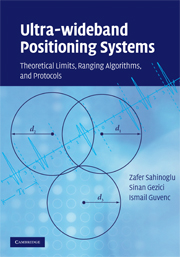Book contents
- Frontmatter
- Contents
- Preface
- 1 Introduction
- 2 Ultra-wideband signals
- 3 Ultra-wideband channel models
- 4 Position estimation techniques
- 5 Time-based ranging via UWB radios
- 6 Ranging protocols
- 7 Special topics in ranging
- 8 Practical considerations for UWB system design
- 9 Recent developments and future research directions
- References
- Index
2 - Ultra-wideband signals
Published online by Cambridge University Press: 23 December 2009
- Frontmatter
- Contents
- Preface
- 1 Introduction
- 2 Ultra-wideband signals
- 3 Ultra-wideband channel models
- 4 Position estimation techniques
- 5 Time-based ranging via UWB radios
- 6 Ranging protocols
- 7 Special topics in ranging
- 8 Practical considerations for UWB system design
- 9 Recent developments and future research directions
- References
- Index
Summary
Commonly, an ultra-wideband (UWB) signal is defined to be a signal with a fractional bandwidth of larger than 20% or an absolute bandwidth of at least 500 MHz. The main feature of UWB signals is that they occupy a much wider frequency band than conventional signals; hence, they need to share the existing spectrum with incumbent systems. Therefore, certain regulations are imposed on systems transmitting UWB signals. In this chapter, after a detailed description of UWB signals, various regulatory rules on UWB systems in different parts of the world are investigated. Then, emerging UWB standards for wireless personal area network (WPAN) applications are studied.
Definition of UWB
Although Guglielmo Marconi's spark gap radio transmitters were sending UWB signals across the Atlantic Ocean in 1901, the rigorous investigation of UWB systems was stimulated by the studies on impulse response characterization of microwave networks in the 1960s [63, 64]. Instead of the conventional swept-frequency response characterization, a linear-time-invariant (LTI) system was characterized by its response to an impulse in the time domain. After employing impulses to characterize behavior of various systems, it was also realized that such impulses could also be used in radar and communications systems [65]. The first UWB communications patent was issued in 1973 to Gerald F. Ross on transmission and reception of baseband pulse signals [66].
Early names for UWB technology include baseband, carrier-free, non-sinusoidal and impulse. The term UWB was coined by the US Department of Defense in the late 1980s. A UWB signal is characterized by its very large bandwidth compared to the conventional narrowband systems.
- Type
- Chapter
- Information
- Ultra-wideband Positioning SystemsTheoretical Limits, Ranging Algorithms, and Protocols, pp. 20 - 43Publisher: Cambridge University PressPrint publication year: 2008



